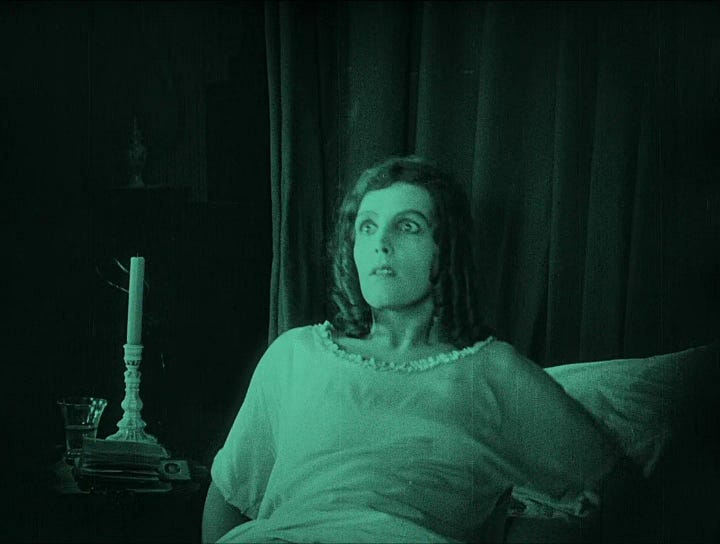Why You Should Watch More Silent Movies
Return to the source...

‘Return to the source’ has long been a favoured strategy of artists seeking to master their craft. Picasso studied African tribal masks. T.S. Eliot devoured classical literature and medieval legend. The director of Mega Shark vs Crocosaurus pored over Steve Irwin YouTube videos.
Returning to the source gives us that most elusive of things: context. Art becomes richer when we understand the patterns, language, and assumptions it’s playing with. This is a fancy way of saying, if you bring f*ck all to art, you’ll get f*ck all out of it.
This holds as true for cinema as for any art form. In fact, what’s cool about film is that, relatively speaking, its historical context is easier to grasp. It is so new compared to its older siblings (a few decades vs hundreds of years) that the lineage from source to present day is far more direct.
‘Cinematic language’ (sigh) was born in silent movies. Close-ups, flashbacks, editing, montage, parallel action, and more took flight before a word was ever uttered on the screen. The vertiginous cross-cutting of, for example, Nolan’s Oppenheimer, was prefigured 100 years previously in Murnau’s Nosferatu:


All movies are implicitly indebted to silent cinema — not to mention the thousands that explicitly pay homage1:

The legendary Indian director Satyajit Ray, writing in the ‘60s, questioned whether the introduction of dialogue to cinema was an “impurity,” poisoning its “direct visual impact.” OK, that’s probably a little extreme, but there is something to the idea that cinema at its purest achieves in images what words cannot express.
(I wrote about this last time: the more that is left to our imagination, the more we become participants rather than consumers).
The best way to grasp this is to, Mr. Miyagi style, strip away the bells and whistles of modern cinema and study its ‘purest’ form.


Without the luxury of dialogue, silent film required “precision of action to a degree unknown in the era of sound,” wrote Ray. “Not just precision of acrobatics, but precision, also, in the use of cutting and of the camera. It was all part of a highly complex and specialised art.”
Take, for example, this short scene from Charlie Chaplin’s The Gold Rush (1925):
It’s worth pausing to appreciate just how much is going on here. The loving way the Tramp wipes the plate as though working in a fancy restaurant. The ceremonial ladling of the ‘juices’ onto the steaming shoe. The darkly funny reveal that it's his own shoe being consumed. The earnest pride with which he presents his meal. The precision with which the shoe is transformed into food: laces twirled like spaghetti, nail ‘bones’ sucked dry (the shoe was apparently made from licorice. I’d rather eat the shoe).
Then there’s Big Jim’s reaction: bafflement, internal struggle, and reluctant acceptance. A mini three-act story within the story.
Finally, underneath it all, the hideous implication of desperate poverty and the delusional, ironic optimism of the Tramp.
Notice that everything I’ve described above is implied rather than stated. This has all been achieved, purely through action, in 2.5 minutes. Such mastery!
Even better, we have participated in the process. “The secret of the silent film,” says Kevin Brownlow in The Parade’s Gone By, “lay in its unique ability to conjure up a situation that closely involved an audience, because demands were made on its imagination. The audience responded to suggestion, supplied the missing sounds and voices, and became a creative contributor to the process of projection.”
Ray, no chump himself, was positively in awe of the craft on display in the above scene:
So, hopefully I’ve convinced one or two of you. I’ve convinced myself anyway, so that’s a good start. For those of us trying to understand cinema better (which, once again for those at the back, will make watching a movie a richer experience), we need to watch more silent films.
Something I find helpful: don’t think of this as homework! Sure, some silent movies will be dull as dishwater, but many of the enduring classics still fucking rock.
The best thing to do is to see these not as dusty historical artifacts, but as living, breathing works of art. The best silent films really are that. Just like The Iliad still rules when you read it today, so Buster Keaton remains funny and shocking and at times outright mind-boggling. Look at this FFS!
What more is there to say?
These essays take time. I want to keep them free for now, but if you've enjoyed my work and would like to support it, please consider buying me a ‘coffee’. I enjoy writing in coffee shops, so you would quite literally be fuelling my next piece!
Dane Benko recently wrote a great piece highlighting three “wordless” movies from the last year or so. One of them, Flow, just won an Oscar. Another, Hundreds of Beavers, has become an indie darling.




Murnau’s "Sunrise" (1927). It revealed something of the timelessness carried in us humans. It confirmed, to me, that the human in us is as it was then, in 1927. Life can be beautiful and dreadful and most of us are blind to the beauty and love that is closest to us.
Pioneers of African American Cinema is an anthology of many silent and early talkies by Black directors. Definitely worth checking out!